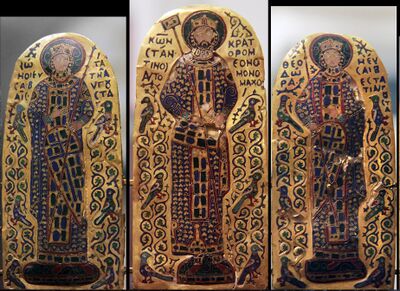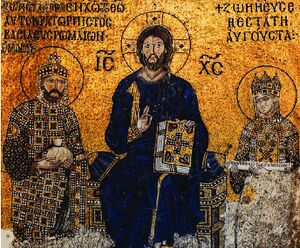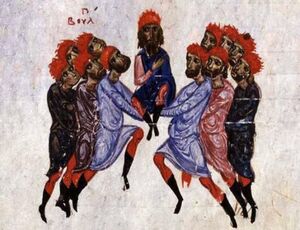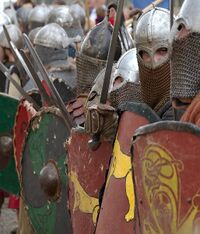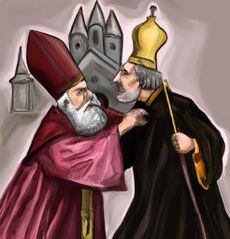Constantine IX
Competence took you only so far in Byzantine politics, the 11th century Christian empire centered in Constantinople. Preferable attributes included a famous family or a tight arse. Or you could have been emperor Constantine IX. Called the best-looking man in the world by friends and family, Constantine got to be Byzantine emperor because an ex-lover ordered it.
This is not to say Constantine was an unmitigated disaster as ruler of a turbulent empire. Just a disaster. He could have averted a major crisis in his reign: the Great Schism of 1054, which saw a parting of the ways between Catholic Christians and Orthodox Christians over an utterly rococo issue.
Family[edit]
Constantine Monomachos (as his driver's licence read) was born into a wealthy aristocratic family around 1000 AD. He was literally a millenial, and behaved as one. The family surname translates as 'I Stand Alone (like a Gladiator)'. A bit pompous. However, Constantine didn't really take to life as an armed defender of the Byzantime Empire. He merely enjoyed wearing armour and looking sufficiently regal whilst riding a horse.
Constantine's father Theodosius got involved in some conspiratorial hanky-panky during the reign of Constantine VIII. For reasons that are lost to history, these Christians did visit Constantine with the sins of his father, though they didn't rise to the level either of confiscation of goods or disfigurement. By this time, Constantine had married; however, in an oversight, he forgot his wife's name and so has history. Constantine drew another blank on the name of his second wife, even though she was the niece of emperor Romanos II. We don't know her but we know they had a daughter called Anastasia, because she went on to marry into the Russian royal family to Vsevolod I of Kyiv. More on that later. This link with Romanos brought Constantine into contact with empress Zoe. Romanos and Zoe had morphed from an imperial couple into an open marriage, allowing each other 'bits on the side'. Constantine was one such 'bit' for Zoe.
We don't know whether Constantine's second wife was alive or aware of her husband's relationship with Zoe, but she appears to have died around 1030, leaving her husband with a daughter. With marital duties now over, Constantine got close enough to Zoe to get him noticed by another of Zoe's paramours, Michael the Paphlagonian, who considered Constantine a rival. When he and Zoe bribed emperor Romanos's bathing attendants to drown him, Michael as emperor Michael IV exiled Constantine to Lesbos, the island that gave its name to the Lesbians. Clearly, Constantine's handsome demeanour was lost on the locals.
Exile and return[edit]
Constantine kept out of trouble on his island exile despite procuring the services of at least two mistresses. He was aware that Michael IV's health was failing in the early 1040s and hoped for a reprieve. In 1041-42, during the chaos and confusion around the fall of emperor Michael V, he received a message from empress Zoe. Did he fancy returning to Constantinople? His exile was over.
Constantine arrived at a time when the imperial government was shaky. The novelty of being ruled by the imperial duo of Zoe and her younger sister Theodora was a prelude for full-blown civil war. One solution was to find a man to share the throne with the warring sisters. By a process of elimination (and possible murder), Constantine was selected and married Zoe. Both had been married and widowed twice. Third time lucky?
But Constantine didn't come alone. He brought his two mistresses: Maria Skleraine (niece of wife number two) and Gurandukht, sister of the King of Georgia. They moved into the imperial palace. These unusual living arrangements (even for a Byzantine ruler) displeased the Orthdox Greek authorities. However, they made a deal to 'stay out of the bedroom' if Constantine let them run things as they saw fit. That was Constantine's big mistake, and not the only one. Ever generous with his favours, Constantine gave the Byzantine aristocratic class a big tax cut to keep them onside. This would mean savings had to be made elsewhere. The Byzantine government defunded the army, confident that the empire was strong enough.
Rebellions and chancers[edit]
Constantine's main self-appointed domestic task was to root out all members of the late Michael IV's family. In this endeavour, he was joined by empress Theodora, likewise long on vengeance. Family members of Michael IV were all mutilated, including deposed emperor Michael V and John the Eunuch (John Orphanotrophos), whom Constantine had seen as the man who had turned a bunch of peasants into the imperial ruling family. This 'counter-jumping' had personally offended Constantine and his aristocratic buddies. However, he faced a more serious threat from General George Maniakes.
Ever since his campaign to reconquer Sicily for the Byzantines had been scuppered by Admiral Stephanos in 1038, Maniakes had been in Southern Italy with his army. He shed no tears over the death of Michael IV or the deposition of Michael V, especially as the latter was the son of Stephanos. This should have made him a natural ally of Constantine IX. Instead, Constantine had Maniakes sacked. The general got even by proclaiming himself emperor and rallying his army of locals and mercenaries to attack Constantinople. In addition, Maniakes used his contacts in the Varangian guard to get hold of a Viking navy from Russia to attack the capital by sea. Why the Kyivian state got involved in this Byzantine civil war is not clear. In 1043, Maniakes invaded the empire from the west and got as far as Thessalonika. There, he met Constantine IX or at least his army. The battle was fierce and Maniakes had the other on the run when he was felled by a spear and died. This immediately took the wind out of the rebels. Those who got away fled back to Italy. The others became a grisly spectacle in the hippodrome at Constantinople. They were forced to ride on donkeys backwards[1]. That was nothing compared to getting their heads chopped off as rebels and traitors.
Whilst this was going on, the Kyivian fleet arrived in the Bosphoros. Though notified that Maniakes was dead, the hostile fleet refused to retreat. Cynical Constantine used his other standby of bribery to make them go away. They did not, until Constantine sent in the specialists: Greek Fire pumped at the wooden vessels did the trick. The Kyivian flotilla scattered, the slower ships turning into blazing infernos. Constantine had scored two victories.
With these victories under his belt, the Byzantine rumour mill suggested Constantine had no further need of Zoe or Theodora and could pack them off to a suitable monastery (the same one — to ensure they made life difficult for each other) and marry his senior mistress, Maria Skleraina. Constantine guessed something was up when he was loudly booed in a religious procession, the populace demanding that the emperor show evidence that the imperial sisters were still alive. Constantine got them out of the palace to wave to the crowds in the hippodrome. The riots which had already started were stopped. Maria died not long after; perhaps Zoe had again found use of her collection of poisons.[2]
Constantine's reputation grew. He revived the University of Constantinople (founded in 425 AD by emperor Theodosius II), which had fallen on financial hard times, and helped rebuild the Church of the Holy Sepulchre in Jerusalem, which had been largely destroyed by a Fatamid caliph a few years earlier. But these brownie points for Constantine did not help dealing with a tribal horde of Pechenegs who lived north of the Danube. They had been handy allies earlier against the Bulgarians but, when the latter were defeated and conquered, the Pechenegs kept attacking all the same. Constantine tried bribery again; the Pechenegs tried raping and pillaging.
A new rebellion that caused Constantine embarrassment came from his nephew, Leo Tornikos. Leo was the son of Constantine's sister Euprepia and had a genuine military record. His only major faults were arrogance and a height issue. The manuscripts portray him as Byzantium's shrimpiest imperial claimant. This time, the rebels came from what is now Bulgaria and Macedonia. Lacking any troops to oppose Leo, Constantine retreated behind Constaninople's walls. Even here, the emperor lacked men he could trust. There was a real danger the gates would be opened and Leo let in. The rebel hesitated. He had hoped his uncle would be deposed by Zoe and Theodora, but they did nothing to assist. Leo sent a force to take the walls, but they were defeated when Constantine put on his finest imperial armour and led his soldiers to victory.
Eventually, a relief army from the eastern frontier arrived in Constantinople. Leo Tornikos's army broke and he was captured. The midget had got closer to killing Constantine than George Maniakes. Leo's life was spared but his hope he would be dispatched so an obscure monastery were dashed when he recognised the official in charge of eye removals. He would be sightless but alive. It was the least he could have expected.
Italian issues[edit]
Byzantine control of southern Italy had been stalled by the failure in Sicily and the death of George Maniakes in 1043. The Byzantine failure to pay their mercenaries meant they would try to carve out their own territories. The Normans from France were keener than their Scandinavian cousins to do so; they had allied with local Lombards to capture former Byzantine territory, but then usually ran the territories to their own benefit. This lead to conflicts between them and the Byzantines.
The growing threat of the Normans produced a strange alliance. Pope Leo IX worried that the hitherto jumble of local Lombard statelets and a stretched Byzantium could be replaced by a far stronger Norman state in his backyard. He first appealed for support from Holy Roman Emperor Henry III, who was his cousin and had basically installed him as Pope in the 1040s after acute confusion about who was really pope. Henry didn't go himself but instead sent troops under the command of Adalbert of Winterthur. Judging that this wouldn't be enough, Leo contacted Constantine. The Byzantines agreed to support Leo. However, in 1053 before their armies could unite, the Normans smashed Leo's army. Not only that, Leo, one of the 'warrior' popes who believed in leading soldiers into battle, was captured and held in captivity. The Normans would release him if he sided against the Byzantines. Leo agreed and was released. Constantine hoped to reverse this, but he had another problem: The Patriarch of Constantinople was involved in his own dispute with Rome and that had just gotten ugly.
Religious strife[edit]
To say relations between Catholic Rome and orthodox Constantinople were bad is an understatement. In the past, there had been theological disputes (veneration of icons and accusations of general bad faith all around). By the 1050s, the two sides were effectively operating as separate churches, though they exuded a veneer of unity and mutual respect for each other's claims to be real Christians. This changed dramatically between 1053-1054 — and over the question of bread!
To celebrate the Eucharist or Holy Communion, the Latin Catholic tradition had been (and still is) to use unleavened bread.[3] The Orthodox went with leavened or 'full' bread. Since bread is used in Holy Communion, to eat the wrong bread was a sin, rendering the hungry supplicant outside God's love and out of communion with true Christians. Since the use of unleavened bread came via the Jews with Passover (and therefore the time of Jesus's death), the Catholics thought they were just following a long-established tradition. On the other hand, the Orthodox believed that a fluffy loaf of bread was a symbolic break with Judaism, along with compulsory circumcision for men and passing on the ham salad.
The bread issue had been overshadowed by other Catholic/Orthodox disputes, such as whether Rome (and its Pope) was surpreme over all churches or just one of the Holy Five (Alexandria, Antioch, Constantinople, Jerusalem and Rome) to act as a team on matters theological; or whether the Holy Spirit came from God alone via Jesus or via God and Jesus in a triangle to emulate Trinity. Since God and Jesus were one person anywhere, according to Christians, they thought this point was obscure, but it was crucial for Patriarch Michael Keroularios.
Overcoming emperor Constantine's objections, Keroularios closed all the empire's churches that practised the Latin rites. He claimed he was doing this in response to Pope Leo IX's agreement with the Normans (still in custody) to stop the Greek customs in the conquered lands. Pope Leo sent letters to Keroularios to argue he was the supreme authority — and sent goons to Constantinople to back it up. By the time Leo's representatives got there, they got the news that the pope had died. Since there was no pope now, the delegation should either wait for instructions from their spiritual leader (when elected) or return home.
No new instructions were forthcoming, so the delegation instead debated with local theologians about everything theological regarding Christianity. Patriarch Michael refused to see them. He was handed a charter of excommunication: He was no longer welcome in a Catholic church. To emphasise their action, the delegation marched into the Hagia Sophia and left a copy of the charter on the altar. Patriarch Michael excommunicated everyone who had taken part. He sent his copy back to Rome.
During all of this, it seems unlikely Constantine quite understood was going on. Perhaps he reasoned there had been bust-ups and schisms before, so a reconciliation was possible soon. He was actually right, though it would take until 1965 to cancel the mutual excommunications in a meeting between Pope Paul VI and Patriarch Athenagoras. Well better late than never but Catholics and Orthodox have never been able to resolve the issues that caused the split in the first place.
Death[edit]
Constantine IX died in early 1055. He had planned to sideline Theodora and break in a new successor but hadn't found a suitable candidate. Theodora ruled by herself. As for Constantine, you can see him in the Hagia Sophia in Constantinople with Zoe and Jesus. He still looks very imperial after a thousand years on a church wall.
References[edit]
| Preceded by: Zoe and Theodora |
Byzantine Emperor 1042–1055 |
Succeeded by: Theodora |

